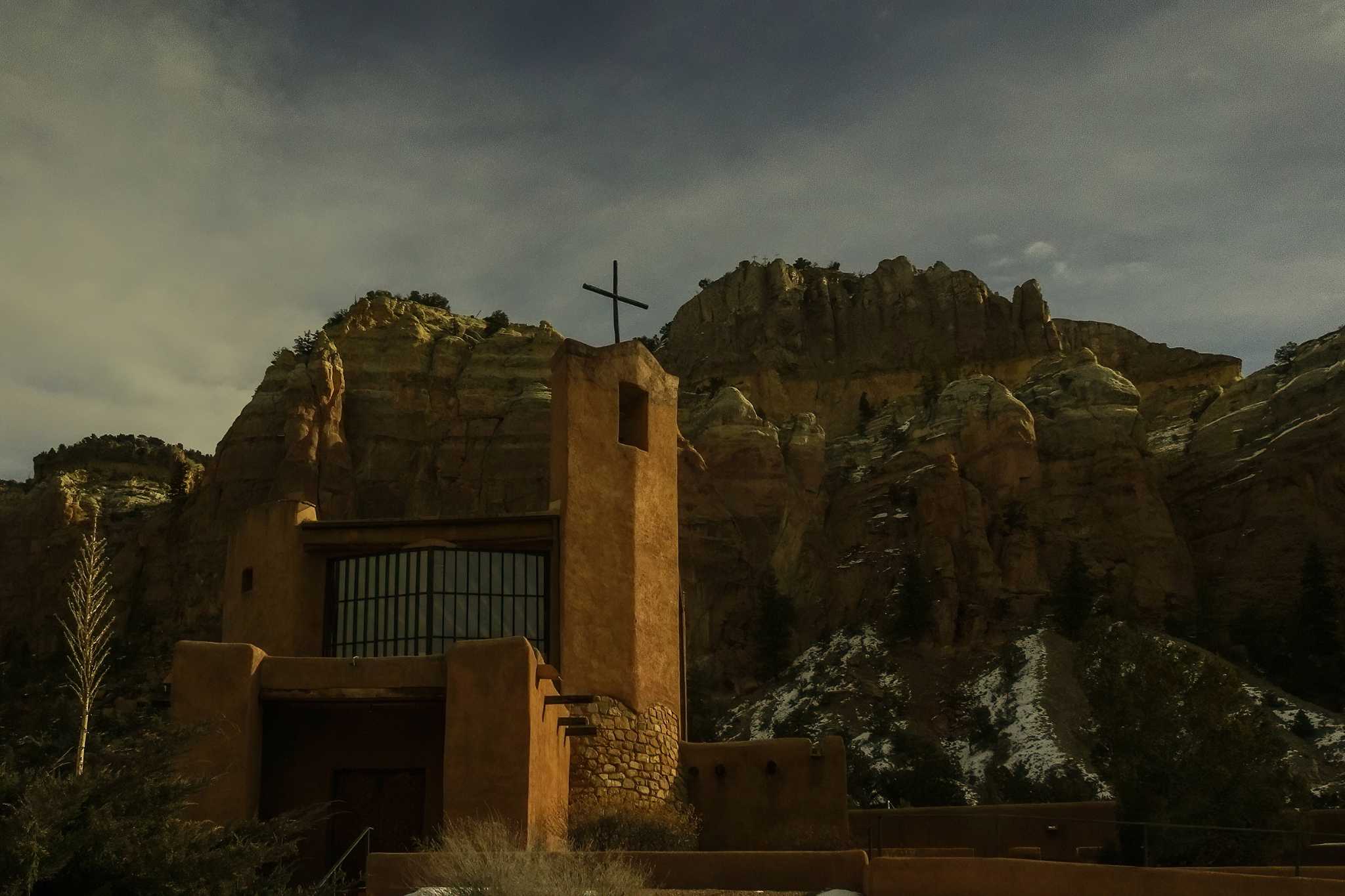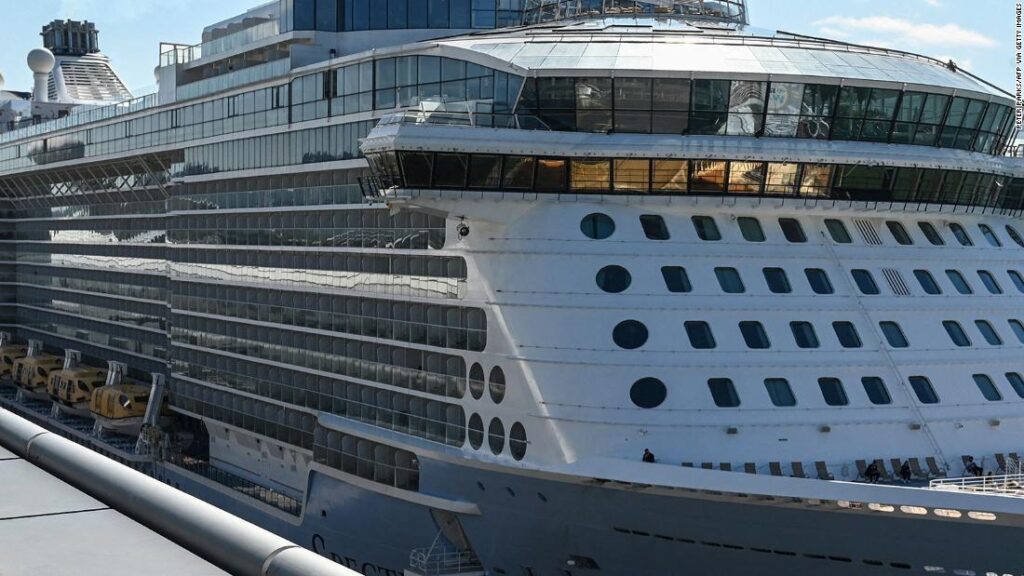 CHAMA RIVER CANYON, N.M.- Hidden in this canyon of crimson sandstone cliffs encompassed by miles of federally protected wilderness, the Monastery of Christ in the Desert seems like an ideal place to ride out a pandemic.
CHAMA RIVER CANYON, N.M.- Hidden in this canyon of crimson sandstone cliffs encompassed by miles of federally protected wilderness, the Monastery of Christ in the Desert seems like an ideal place to ride out a pandemic.
For more than 50 years, a small community of Benedictine monks has quietly lived, worked and worshiped here in a cluster of off-grid adobe buildings along the banks of northern New Mexico’s Chama River.Considered the most remote Catholic monastery in the hemisphere, it can be reached only by a 13-mile single-lane earthen road that winds through the canyon.Abiquiu, the closest village – population 151 – is 25 miles away.Groves of cottonwood and willows line the river where bald eagles hunt for rainbow trout.
Black bears, coyotes and cougars prowl the pinyon- and sage-scented Santa Fe National Forest, which surrounds the monastery.
Despite the difficult journey, outsiders have flocked to this serene abbey for decades in search of spiritual renewal.
As adherents of the sixth-century Rule of Saint Benedict, which teaches that monasteries are to treat visitors as they would Jesus himself, the monks graciously welcome outsiders.As many as 30,000 people make the pilgrimage each year, including past notables such as the artist Georgia O’Keeffe and the actor Matthew McConaughey.Guests are an integral part of Benedictine monastic life and have been for 1,500 years.”Monasteries,” Saint Benedict wrote, “are never without them.”
That was true for Christ in the Desert until March 2020, when the coronavirus pandemic forced the monks to close their doors to the outside world.For nearly two years now, guests have been prohibited from staying at the monastery, leaving the monks in a position they have never faced before.
“Guests are part of who we are,” said Brother Chrysostom, the monastery’s bearded guestmaster, who joined the fellowship in 2017.”We can only go so long without guests, and not just for financial reasons.
For identity reasons.Not having visitors would betray the whole Benedictine charism.”
– – –
The monks had little choice.
Given their communal living arrangements, monastic communities are particularly vulnerable in a pandemic.Nine monks from the monastic community of Mount Athos in Greece have died of covid-19.Last February, two nuns at the St.Walburg monastery in Villa Hills, Ky., died after 28 sisters were infected with the coronavirus.
Outbreaks occurred in monasteries worldwide, including in Italy, the Philippines and Ukraine.With elderly brothers at the Christ in the Desert – the oldest is 95 – a coronavirus outbreak could have proved a death sentence.
To protect themselves, the monks blocked the entrance with a gate.
“PLEASE DO NOT ENTER OUR PROPERTY,” a prominent sign pleaded.”WE HAVE HIGH-RISK INDIVIDUALS IN OUR COMMUNITY.”
Some outsiders ignored their request.
“People tried to storm the door, and I’d say, ‘No, you can’t come in here,’ ” Brother Chrysostom said.”They just disregarded the gate and came in anyway.Some understood, and some were very upset about it.
It was just what we had to do.If one of us gets covid, we all get it.”
It was a decision they did not make lightly.The guesthouses and gift shop have traditionally served as the monastery’s primary sources of income, a necessity to fulfill Benedict’s order that monasteries be self-sustaining.In exchange for a donation ranging from $85 for individuals and $170 for couples, guests receive a simple room and three daily meals.They may attend services and Mass in the chapel with the monks, explore the canyon and, if they wish, work alongside the brothers during their morning labor period.The monastery has eight guest rooms available and can accommodate 13.Guests stay a minimum of two nights and can arrange visits lasting several weeks.
Benedictine monasteries have always provided spaces for refuge, peace and reflection, a reprieve from the stormy fellowship of human life, as Saint Augustine put it.World-weary pilgrims have especially sought them out in times of collective national distress and hardship.
After World War II, monasteries worldwide received an influx of applications.In the months after the Sept.11, 2001, terrorist attacks, Christ in the Desert was flooded with guests seeking spiritual guidance.But in this present moment of collective trauma and loss, the monks have been restricted from providing such a haven, unable to fulfill a part of their divinely ordained mission.
While the monastery was closed to guests for the first time since it was founded in 1964, the brothers turned inward.
The community also shrank, from almost 60 in 2019 to 23 today.
“One thing that has changed is that it has allowed us to consolidate and coalesce as a community.Without visitors, we just have ourselves,” Brother Chrysostom said.”We’re less self-conscious about what we’re doing, especially younger monks.It’s so easy to get into a performance sometimes.”
The monastery keeps a tight schedule, and in that regard, life among the brothers changed very little while it was closed to guests.They still rose before dawn for Vigils at 4 a.m.and returned throughout the day to chant the psalter together inside the solar-powered adobe chapel; they attended Mass every morning and ate communal meals in silence.
They worked on projects to sustain the community, focusing on weaving, cooking, laundry and maintenance.And they prayed, continually, for those suffering from covid-19, for the world, for God’s grace in exceedingly trying times.
The monks also responded to the pandemic in ways that feel relatable to those who have experienced it beyond the safety of the canyon.Brothers who made trips to town for supplies quarantined before reentering the community.Before health officials brought lifesaving vaccines in early 2021, the monks kept their distance from one another during services in the chapel and meals in the dining hall.For more than a year, some monks never left the canyon.Because of these measures, no one at Christ in the Desert has tested positive for the coronavirus.
When Brother David quarantined as a precaution for two weeks in March 2021, he passed the time by painstakingly lining up 2,000 dominoes that wound through his room in a dazzling display of brightly colored labyrinthine loops, spirals and patterns.
He posted a video of his achievement on YouTube.”Being quarantined for 2 weeks has been wonderful,” he wrote on his channel.”I could go [on] for a few more weeks if it was not for the fact, I am unable to attend Mass.”
The isolation allowed the monks space to devote time to new projects.Since 2020, they have transformed their property through an ambitious agricultural program spearheaded by Abbot Christian Leisy, who was elected to the position in 2018.
The monks acquired a herd of Navajo-Churro sheep, goats, chickens and a black-and-white guard donkey named Matty who chases away predators.They continued to work on a five-year program during the pandemic to develop gardens, livestock, pastures and orchards on the land.They recently constructed a greenhouse to grow fresh fruit and vegetables.
– – –
The isolation during the pandemic has provided the monks the opportunity to experiment in ways that would have been more difficult with guests, said Father Columba, a monk from Canada who is overseeing much of the monastery’s agricultural endeavors.
“It gave us the enclosure, to be honest, to develop unhindered,” he said.”The donkey is very territorial.
When we have guests we won’t be able to do what we’ve been doing.We’ll have to enclose.”
The agriculture projects have allowed the monks to become less reliant on trips to town for supplies.
“We’re not anywhere close to self-sufficient,” Brother Chrysostom said.”We rely on our Our Lady of Walmart and Costco.”
Unable to share their life and work in person, some of the monks created YouTube channels, which provide a glimpse of life behind the adobe.Brother David, who goes by the social media alias “The Desert Monk,” has showcased the brothers building a solar-powered irrigation system, cooking in the kitchen, installing an electric fence, harvesting Christmas trees, weaving wool in their shop and raising a baby lamb named Shadow.On the monastery’s official YouTube channel, Abbot Christian led a tour of spring flowers, introduced viewers to a new hen, Linda, and walked through the vegetable garden full of squash, lettuce, onion, pumpkins, cherry tomatoes and kale.”Wish you were here,” he laments on camera, standing next to a new chicken coop.”We all know why you’re not.”
The entrepreneurial spirit is nothing new for the monastery.
To support themselves financially, the monks have adopted creative income streams over the years.Until recently, they grew hops and sold Monk’s Ale beer; in the mid-2000s, they played a starring role in a reality show on the Learning Channel – “Truly it is a challenge to use television to spread the Gospel,” the abbot at the time remarked afterward – and they signed a record deal to make albums of their chanting.
As early adopters of the Internet in the mid-1990s, they built their own website and realized that they had a knack for Web design.Using a modem connected to a mobile phone powered by solar panels, they started a business building websites that became an international media sensation.They consulted with the Vatican on the Holy See’s website.At one point, the high level of traffic to their monastery site caused the entire Internet in the state of New Mexico to crash.The enterprise was so successful, however, that they had to shut it down; monks work only a few hours a day, and the website-design business risked crowding out other spiritual disciplines.
Without guests to care for, Brother Chrysostom, 57, has explored new pursuits.He writes the monastery newsletter and he built an apiary to provide honey for the community.
Years ago, the monastery’s last attempt at beekeeping was thwarted by a bear that ransacked the hives.
As a former academic with several advanced degrees, including from the Massachusetts Institute of Technology, Johns Hopkins and the University of Pennsylvania, Brother Chrysostom spent the pandemic earning a certificate in hotel management from Cornell University and he’s pursuing an MFA in creative writing at the University of St.Thomas in Houston.
As a musician who was part of a civic orchestra and a jazz trio in his past life, he occasionally retreats to a small adobe outbuilding – where he stores a double upright bass and a keyboard – to play in his free time.The walls are decorated with icons of Saint Ruth, Saint Mary Magdalene and Saint John Chrysostom, his namesake.A photo of jazz bassist Charles Mingus sits on a small table.
Brother Chrysostom and his fellow monks are looking to 2022 as the year that normalcy returns.
In late August, the monks began receiving day visitors.They plan to finally welcome back overnight guests at the end of February, nearly two years after the gates went up.
Like much of the rest of the world, the pandemic, despite all its horror, gave the monks an opportunity to pause and reset.Guests who return may discover a different place from the monastic community they visited before the closure.
“I think that it’s been a very good time for us.A restful time.It has been a chance for us to slow down and actually become acquainted with one another,” Brother Chrysostom said.
“People will probably notice a different feel in the community as a result of it, in a positive direction.”
Read More
Two brothers were separated in India during the partition.74 years later, they have finally reunited.
After decades, Biden plans to make mobile homes greener.But it’s sparked a fierce debate.
After one year in office, what has Biden done about the four crises he pledged to address?
Subscribe to The Post Most newsletter for the most important and interesting stories from The Washington Post..
